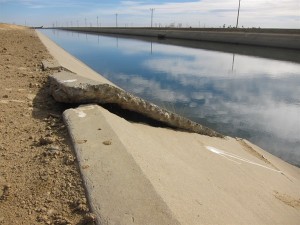By Vicki Kretsinger Grabert.
“A broad consensus appears to be building among California water users and policymakers that it is high time to establish an effective, statewide framework for groundwater management.”
— Groundwater Resources Association of California, Contemporary Groundwater Issues Council
As California strains under a third straight year of drought, Gov. Jerry Brown and many legislators have shown strong interest in modernizing management of groundwater – the state’s most important drought reserves. At the same time, a group of nearly 40 leading water professionals and scholars has been exploring ways California can move forward with more effective groundwater management. Organized by the Groundwater Resources Association of California, the Contemporary Groundwater Issues Council of scientists, economists, consultants, policymakers and regulators recently developed a set of consensus recommendations [1]. Council co-chairs Vicki Kretsinger Grabert, Thomas Harter and Tim Parker outline eight points that the group considers critical to moving California’s groundwater management into the 21st century.
Local management
1. To further and support local groundwater management, the state should:
- Identify local groundwater needs and problems at the basin or sub-basin level.
- Identify local and regional areas in need of more formal groundwater governance structures.
- Identify relevant local governance entities (such as water management agencies) and stakeholders, facilitate a process and timeline for developing local governance structure and identify a backstop if local management is ineffective.
- Identify and develop financing mechanisms to support local management capacity.
- Increase funding for state agencies to provide consistent technical support, quality assessment and backstop capability when local efforts are insufficient.
- Facilitate development and implementation of local groundwater management plans.
Measurable basin management objectives
2. To achieve groundwater sustainability, local basin plans’ management objectives should address:
- Land subsidence
- Ecosystem health
- Surface-water flow depletions
- Water quality, including salinity and seawater intrusion
- Sustaining groundwater levels
- Economic viability of pumping costs
- Public health
- Manageability of groundwater basin as a storage reservoir
3. Water budgets should be established for each managed basin or sub-basin to define changes in storage and assess long-term drought and seasonal groundwater sustainability.
4. Local and state agencies should ensure successful water budget development and document adverse impacts through comprehensive basin data collection, including:
- Aquifer depth-specific groundwater levels
- Aquifer depth-specific water quality measurements
- Aquifer characterization
- Consumptive use, including crop evapotranspiration
- Metering of large pumpers and estimates of pumping by small pumpers
- Precipitation
- Stream gauging
- Land subsidence
5. To manage local groundwater sustainably, local or regional entities should:
- Measure, assess and report on aquifer conditions
- Review and recommend specific policy and management actions to meet basin management objectives
- Develop mutually compatible objectives for sub-basins connected to neighboring sub-basins, with state water authorities acting as a backstop
Data management and information sharing
6. State and local agencies should make data more accessible.
- Data on pumping, well-drillers’ reports and other groundwater information can better inform analyses and computer models, which provide insights into better groundwater management
- State constraints on data access are outdated and complicate data compilation
7. Make groundwater data more transferrable.
- Coordinate access to data archives
- Consolidate databases as appropriate
- Develop easily accessible data houses [2] or web portals [3] linking multiple databases [such as the California Statewide Groundwater Elevation Monitoring (CASGEM) and Advisory Committee on Water Information] to build local capacity, maintain local control and link to other data
- Front-end search engines can facilitate data searches
- Databases should be available to local groundwater managers
8. Develop minimum monitoring standards for groundwater levels, groundwater quality, water budgets, subsidence and reporting.
Groundwater resources in many areas of California are depleted to levels never before experienced in state history. At the same time, a broad consensus appears to be building among California water users and policymakers that it is high time to establish an effective, statewide framework for groundwater management.
Such a framework is needed to define and protect private groundwater-use rights and public interests in groundwater sustainability. Implementation of this framework will require strong local and regional leadership, clear mandates from the Legislature and secure funding.
[divider] [/divider]
Vicki Kretsinger Grabert is president of Luhdorff & Scalmanini, consulting engineers in Woodland. Thomas Harter is a groundwater specialist with the Cooperative Extension and the Center for Watershed Sciences at UC Davis. Tim Parker is president of Parker Groundwater, a groundwater consulting firm in Sacramento. The three are on the Groundwater Resources Association of California board of directors.





